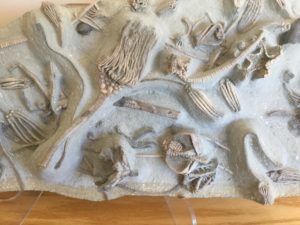
These incredibly well-preserved Crinoids from Indiana are – like the Crinoids found on the west side of the Teton Range – a product of the Mississippian period. Photograph by Mike Scher.
KEEPING ONE EYE ON THE BIGGER PICTURE July, 2016
It is easy to understand why some people are so obsessed with fossils. Our geography and weather, our families and friends, hopes and dreams, plans and schemes – all of the substance that constitutes our individuality and daily existence – is challenged by even the humblest of fossils. We get to sit around camp fires and sushi bars and argue about whether or not we posses a genetic memory of the last ice age, as if this earth that nurtures us was made for this moment and we, the great engineers of our own good fortunes, deserve credit for the smashing success that is the human experience. So far.
But fossils offer a bigger perspective. Preserved within the very earth that feeds us are voices from the past, voices of former inhabitants of this planet. Life forms that had their time in the sun and are now no more. These voices remind us – if we are willing to listen – that many, many forms of life existed here long, long before we did and that they found their extinction in sometimes subtle and sometimes terrible events that were utterly and entirely beyond their control.
Fossils teach us that species come and species go. Meanwhile, the earth lives on for so long as it will. The phylogenic tree with its beautiful homo sapiens blossoms is rooted in a deep stratigraphic column of failed life forms, their fossilized remains forming the narrative of how we became human and warning us that their past is the key to our future. Fossils challenge the notion that we are in control of the terms and conditions of our tenancy here on earth. And they remind us that every day is a gift that we did not earn and perhaps do not deserve.
This Tuesday, (July 5th) at the Teton County Library Auditorium at 6:00 pm we get to hear from BYU Idaho Professor Forest Gahn about marine creatures that lived here (“here” being complicated by the fact that what is Wyoming today was near the equator then) 350 million years ago. Professor Gahn has “listened” to these fossils – the Teton Crinoids – very carefully. He can tell us much about their day in the sun
